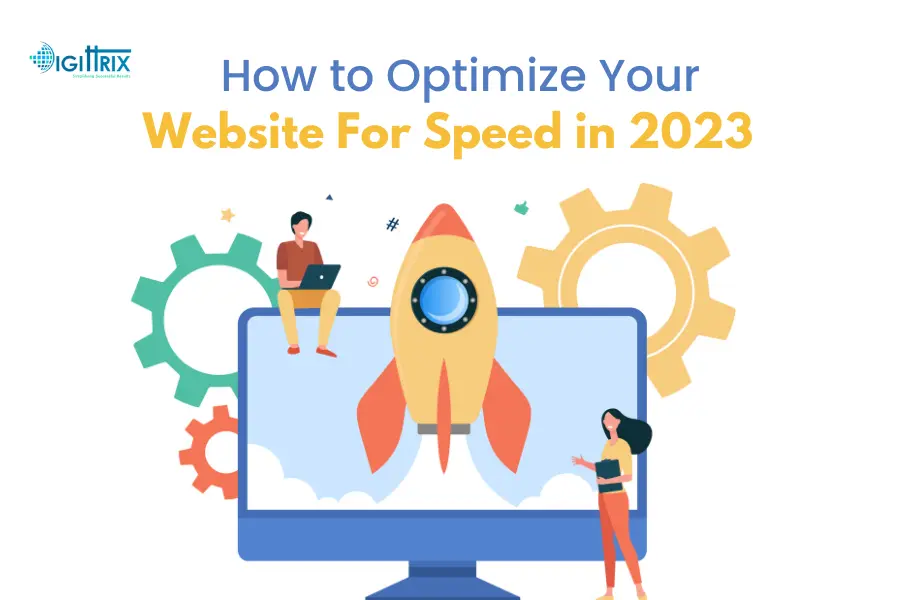Website speed is important for user experience, search rankings, and conversions. A faster site keeps visitors engaged and helps drive more traffic and revenue.
Highlights
An enthusiastic developer and skilled business management expert with over a decade of experience in the field

In today's digital landscape, speed is not just a luxury but a necessity for online success. With the internet becoming faster and users' attention spans shorter than ever, a slow-loading website can cost you precious visitors, conversions, and ultimately, revenue.
That's why we're here to guide you through the latest techniques and strategies to optimize your website for speed in 2023 and beyond. Whether you're a seasoned web developer or a business owner looking to enhance your online presence, this comprehensive guide will equip you with the knowledge and tools needed to make your website lightning-fast.
So, let's dive in and unlock the secrets to securing that coveted number-one spot on Google while delivering an exceptional user experience. Get ready to accelerate your website and leave your competition in the dust!
Launching a startup? Discover the crucial steps to take after launching your website for sustained growth and success.
In this section, we will explore why website optimization for speed is crucial in today's digital landscape. We'll highlight the impact it has on user experience, search engine rankings, and overall business success.
A slow-loading website frustrates visitors and leads to high bounce rates. Users expect fast and seamless browsing experiences, and optimizing your website's speed ensures a positive user journey.
Search engines, like Google, prioritize fast-loading websites in their algorithms. Optimizing your website's speed improves its chances of ranking higher in search engine results pages (SERPs), driving more organic traffic to your site.
With the majority of internet users accessing websites through mobile devices, having a fast-loading, mobile-friendly website is paramount. Optimizing for speed ensures your site is accessible and enjoyable across various devices and screen sizes.
Slow-loading websites have been proven to negatively impact conversion rates. Users are more likely to abandon a purchase or form submission if a website takes too long to load. By optimizing your site's speed, you can increase conversions and boost revenue.
In today's competitive online landscape, having a fast website gives you an edge over your competitors. A speed-optimized site attracts and retains more visitors, establishing your brand as reliable and trustworthy.
Remember, understanding the importance of website optimization for speed is the first step towards achieving a top-ranking position on Google and providing an exceptional user experience.
Unlock your business's full potential! Discover Digittrix's insights on custom web development and take your business to the next level.
Before diving into optimization techniques, it's essential to assess your website's current performance. This section will guide you through evaluating your site's speed and identifying areas for improvement. By understanding where your site stands, you can make informed decisions about which optimization strategies to implement. According to Portent, A 1-second delay in load time drops conversions by 7%, hurting online sales significantly.
Measure the time it takes for your web pages to fully load. Use tools like Google PageSpeed Insights, GTmetrix, or Pingdom to obtain detailed reports on your site's performance. Identify any slow-loading pages that require attention.
Evaluate how quickly your server responds to requests. Slow server response times can significantly impact overall website speed. Use tools like WebPageTest or Pingdom to analyze your server response times and identify potential bottlenecks.
If you're utilizing a CDN, evaluate its performance in delivering your website's assets. Check if the CDN is properly configured and optimized for speed. Look for any potential issues that might be affecting content delivery.
Test your website's speed and performance on various mobile devices. Use mobile-specific testing tools like Google's Mobile-Friendly Test or PageSpeed Insights' mobile analysis to identify areas where your site may need improvement for optimal mobile performance.
Consider the overall user experience when browsing your website. Evaluate factors such as ease of navigation, intuitive design, and efficient content loading. Take note of any user pain points that may be related to slow loading times.
By thoroughly evaluating your website's current speed and performance, you can pinpoint specific areas that need improvement. This analysis will serve as a foundation for implementing targeted optimization strategies in the subsequent sections. Remember, a thorough evaluation is crucial for identifying the most effective steps to enhance your website's speed.
In this section, we will explore effective and proven techniques for optimizing your website's speed. These best practices will help you streamline your site's performance, reduce load times, and provide a seamless browsing experience for your visitors. Think with Google information shows that websites taking over 3 seconds to load lose 53% of mobile users immediately.
Compress and optimize images to reduce their file sizes without compromising quality. Use image compression tools or plugins to ensure images are properly optimized for the web, leading to faster load times.
Minify your HTML, CSS, and JavaScript files by removing unnecessary characters, whitespace, and comments. Additionally, concatenate multiple files into a single file to reduce the number of requests made by the browser.
Implement browser caching to store static files locally on visitors' devices. This allows returning visitors to load your website faster by retrieving cached files instead of making new requests to the server.
Utilize a CDN to distribute your website's assets across multiple servers worldwide. This ensures faster content delivery to users by serving files from the nearest server location, reducing latency and improving overall speed.
Implement lazy loading for images and videos, where media content is loaded only when it enters the viewport. This technique reduces initial load times by deferring the loading of non-visible content until it's needed.
Optimize your website's code by removing unnecessary or redundant scripts, reducing the use of external resources, and ensuring efficient coding practices. Cleaner and streamlined code improves loading speed and overall performance.
Choose a reliable and fast web hosting provider that can handle your site's traffic and demands. Look for hosting solutions that offer SSD storage, caching mechanisms, and optimized server configurations for optimal performance.
By implementing these best practices, you can significantly improve your website's speed and provide a smooth and enjoyable user experience. Remember, a combination of various optimization techniques tailored to your specific needs will yield the best results.
In this section, we will explore the latest cutting-edge tools and technologies that can help enhance your website's performance in 2023. By leveraging these tools, you can stay ahead of the curve and ensure your website delivers optimal speed and user experience. Google Developers show google prioritizes fast-loading pages, improving SEO rankings and boosting organic traffic reach.
Utilize advanced performance monitoring tools like New Relic, Datadog, or Dynatrace to gain real-time insights into your website's performance. These tools provide detailed metrics, diagnostics, and alerts to identify and address performance issues promptly.
Familiarize yourself with Google's Web Vitals, a set of key metrics that measure user-centric performance. Tools like Google Search Console and Lighthouse can assess your website's Core Web Vitals, including metrics like Largest Contentful Paint (LCP), First Input Delay (FID), and Cumulative Layout Shift (CLS).
Consider implementing Progressive Web App technologies to provide fast, app-like experiences to your users. PWAs leverage service workers and caching mechanisms to deliver offline capabilities and near-instant loading, enhancing the overall speed and user engagement.
Explore the use of Accelerated Mobile Pages, a framework that optimizes web pages for fast loading on mobile devices. AMP utilizes streamlined HTML and pre-rendering techniques to deliver instant loading experiences, especially in mobile search results.
Stay up-to-date with the latest versions of the HTTP protocol. HTTP/2 and HTTP/3 offer improved performance through features like multiplexing, server push, and reduced latency. Ensure your website is utilizing these protocols for faster data transfer and enhanced speed.
Set performance budgets to define specific thresholds for various performance metrics. Tools like Calibre or SpeedCurve can help you establish and monitor these budgets, ensuring your website remains within acceptable performance limits.
Implement automated performance testing as part of your development process. Tools like WebPageTest, Lighthouse CI, or Sitespeed.io can be integrated into your CI/CD pipeline to catch performance regressions early and ensure ongoing optimization.
By leveraging these cutting-edge tools and technologies, you can proactively enhance your website's performance, keep up with evolving standards, and provide an outstanding user experience in 2023 and beyond. Remember, staying informed and adopting the latest tools and practices will give you a competitive edge in the fast-paced digital landscape.
In this section, we will discuss the importance of ongoing monitoring and maintenance to ensure your website maintains its optimized speed in the long run. By implementing effective monitoring strategies and following maintenance best practices, you can sustain excellent performance and provide a seamless user experience.
Conduct periodic performance audits to assess your website's speed and identify any performance bottlenecks or issues. Use tools like Google PageSpeed Insights, GTmetrix, or WebPageTest to generate reports and analyze areas for improvement.
Implement continuous website speed monitoring using tools like Pingdom, UptimeRobot, or SpeedCurve. Regularly monitor your website's response times and page load speeds to identify any performance regressions or anomalies.
Employ error monitoring and debugging tools like Sentry, Rollbar, or Bugsnag to identify and fix performance-related errors. Addressing issues promptly can prevent them from impacting your website's speed and overall performance.
Regularly review and optimize your website's content. Remove outdated or redundant content, optimize images, and streamline code to ensure your site remains lightweight and fast. Perform routine content audits to maintain optimal performance.
Keep your website's software, CMS, and plugins up to date. Regularly check for updates and install them promptly to leverage performance improvements, bug fixes, and security enhancements provided by the latest versions.
Continuously monitor and enforce your performance budgets to ensure your website remains within acceptable speed limits. Regularly assess and optimize your website's assets to stay within the defined thresholds.
Gather feedback from users regarding your website's speed and performance. Conduct usability testing and user surveys to identify pain points and areas for improvement. Use this feedback to make data-driven decisions and optimize your site accordingly.
By implementing these monitoring and maintenance strategies, you can proactively address performance issues, ensure optimal speed, and provide a seamless user experience over the long term. Remember, consistent monitoring and maintenance are essential for sustaining excellent website performance and meeting user expectations.
Ready to optimize your website for speed and dominate the digital landscape? Don't let slow loading times hold you back! Hire our expert team today and let us supercharge your website's performance. With our deep knowledge of the latest speed optimization techniques and cutting-edge tools, we'll ensure your website ranks number one on Google while delivering lightning-fast user experiences. Don't wait any longer—contact us now and unlock the full potential of your website. Let's make speed your competitive advantage!

Do you need help in Web Development ?




Join over 1500+ businesses we've already helped!
Website speed optimization is crucial because it enhances user experience, improves search engine rankings, boosts conversion rates, and provides a competitive advantage in the online marketplace.
Key techniques include image optimization, minification and concatenation of files, caching, content delivery network (CDN) usage, lazy loading, code optimization, and selecting a reliable web hosting provider.
Tools like Google PageSpeed Insights, GTmetrix, or Pingdom can measure your website's speed and provide detailed reports on performance metrics.
Error monitoring and debugging tools like Sentry, Rollbar, or Bugsnag help identify and fix performance-related errors, ensuring optimal website speed.
Hiring experts in website speed optimization brings specialized knowledge and experience to your project. They can leverage the latest techniques and tools, implement best practices, and ensure your website delivers exceptional speed and performance, leading to improved rankings, conversions, and user satisfaction.

©2025Digittrix Infotech Private Limited , All rights reserved.